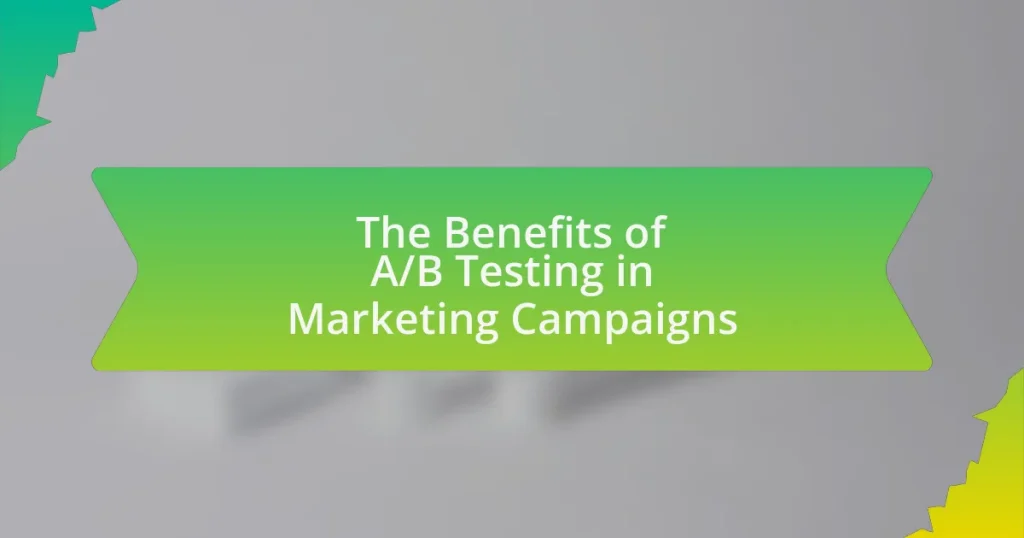A/B testing is a crucial method in marketing campaigns that allows marketers to compare two versions of a marketing asset to determine which performs better based on specific metrics such as conversion rates and click-through rates. This article outlines the importance of A/B testing, highlighting its key components, benefits, and the insights it provides into customer behavior. It also addresses common challenges and pitfalls marketers may encounter, along with best practices for effective implementation. Additionally, the article explores the role of technology and artificial intelligence in enhancing A/B testing processes, as well as practical tips for marketers to optimize their campaigns through data-driven decision-making.

What is A/B Testing in Marketing Campaigns?
A/B testing in marketing campaigns is a method used to compare two versions of a marketing asset to determine which one performs better. This technique involves splitting the audience into two groups, where one group is exposed to version A and the other to version B. The performance of each version is measured based on specific metrics, such as conversion rates or click-through rates, allowing marketers to make data-driven decisions. A/B testing is widely recognized for its effectiveness; for instance, a study by Optimizely found that A/B testing can lead to conversion rate increases of up to 49%.
How does A/B Testing work in marketing?
A/B testing in marketing involves comparing two versions of a marketing asset to determine which one performs better. In this process, a sample audience is divided into two groups; one group is exposed to version A, while the other group sees version B. The performance of each version is measured based on specific metrics, such as conversion rates or click-through rates, to identify which version yields better results. Research indicates that A/B testing can lead to significant improvements in marketing effectiveness, with companies reporting conversion rate increases of up to 49% after implementing A/B tests.
What are the key components of A/B Testing?
The key components of A/B Testing are the control group, the variant group, the metric for measurement, and the statistical analysis. The control group represents the original version of the variable being tested, while the variant group includes the modified version. The metric for measurement, such as conversion rate or click-through rate, quantifies the performance of each group. Statistical analysis determines the significance of the results, ensuring that any observed differences are not due to random chance. These components work together to provide actionable insights that can enhance marketing campaign effectiveness.
How is a control group established in A/B Testing?
A control group in A/B testing is established by randomly selecting a subset of participants who will not be exposed to the experimental treatment or variation. This random selection ensures that the control group is statistically similar to the experimental group, allowing for a valid comparison of outcomes. Research indicates that randomization minimizes bias and helps isolate the effect of the treatment, making it a critical component of effective A/B testing methodologies.
Why is A/B Testing important for marketers?
A/B testing is important for marketers because it enables data-driven decision-making by comparing two versions of a marketing element to determine which performs better. This method allows marketers to optimize their campaigns based on actual user behavior rather than assumptions. For instance, a study by Optimizely found that A/B testing can lead to conversion rate increases of up to 49%. By systematically testing variations in elements such as headlines, images, or calls to action, marketers can identify the most effective strategies, ultimately improving ROI and enhancing customer engagement.
What insights can A/B Testing provide about customer behavior?
A/B Testing provides insights into customer behavior by revealing preferences and decision-making patterns based on their responses to different variations of marketing elements. This method allows marketers to compare two or more versions of a webpage, email, or advertisement to determine which one performs better in terms of conversion rates, click-through rates, or engagement levels. For instance, a study by Optimizely found that A/B Testing can lead to conversion rate improvements of up to 49% when the winning variant aligns closely with customer preferences. By analyzing the data from these tests, businesses can make informed decisions that enhance user experience and optimize marketing strategies, ultimately leading to increased customer satisfaction and loyalty.
How does A/B Testing contribute to data-driven decision making?
A/B Testing contributes to data-driven decision making by providing empirical evidence on the effectiveness of different marketing strategies. This method allows marketers to compare two or more variations of a campaign by measuring performance metrics such as conversion rates, click-through rates, and user engagement. For instance, a study by Optimizely found that companies using A/B Testing saw an average conversion rate increase of 49%. By relying on actual user data rather than assumptions, A/B Testing enables businesses to make informed decisions that enhance marketing effectiveness and optimize resource allocation.

What are the main benefits of A/B Testing in marketing campaigns?
The main benefits of A/B testing in marketing campaigns include improved conversion rates, enhanced customer insights, and data-driven decision-making. A/B testing allows marketers to compare two versions of a campaign element, such as an email subject line or landing page, to determine which performs better. According to a study by Optimizely, companies that utilize A/B testing can see conversion rate improvements of up to 49%. This method provides valuable insights into customer preferences and behaviors, enabling marketers to tailor their strategies effectively. Additionally, A/B testing fosters a culture of experimentation, allowing businesses to make informed decisions based on empirical data rather than assumptions.
How does A/B Testing improve conversion rates?
A/B testing improves conversion rates by allowing marketers to compare two versions of a webpage or campaign to determine which one performs better. This method provides data-driven insights, enabling marketers to make informed decisions based on user behavior and preferences. For instance, a study by Optimizely found that A/B testing can lead to conversion rate increases of up to 49% when the winning variant is implemented. By systematically testing elements such as headlines, images, and call-to-action buttons, businesses can optimize their marketing strategies and enhance user engagement, ultimately leading to higher conversion rates.
What specific changes can lead to higher conversion rates?
Specific changes that can lead to higher conversion rates include optimizing website design, improving call-to-action (CTA) placement, and enhancing content relevance. For instance, A/B testing different layouts can reveal which design elements resonate more with users, leading to increased engagement and conversions. Research shows that changing the color and positioning of CTAs can boost click-through rates by up to 200%. Additionally, tailoring content to match user intent and preferences can significantly improve conversion rates, as personalized experiences have been shown to increase customer satisfaction and loyalty.
How can A/B Testing identify the most effective marketing messages?
A/B Testing identifies the most effective marketing messages by comparing two or more variations of a message to determine which performs better based on specific metrics. This method involves splitting an audience into segments, where each segment is exposed to a different version of the marketing message. By analyzing the performance data, such as click-through rates or conversion rates, marketers can identify which message resonates more with the target audience. Research indicates that companies using A/B Testing can increase conversion rates by up to 300%, demonstrating its effectiveness in optimizing marketing strategies.
What cost benefits does A/B Testing offer?
A/B testing offers significant cost benefits by optimizing marketing strategies and improving conversion rates. By comparing two versions of a campaign, businesses can identify which variant performs better, leading to more effective allocation of marketing budgets. For instance, a study by Optimizely found that companies using A/B testing saw an average conversion rate increase of 30%, which directly translates to higher revenue without increasing costs. This data illustrates that A/B testing not only reduces wasted expenditure on ineffective campaigns but also enhances overall return on investment (ROI).
How can A/B Testing reduce marketing spend?
A/B Testing can reduce marketing spend by identifying the most effective strategies and eliminating underperforming options. By comparing two versions of a marketing asset, businesses can determine which one yields better results, such as higher conversion rates or lower customer acquisition costs. For instance, a study by Optimizely found that companies using A/B Testing saw an average conversion rate increase of 49%, allowing them to allocate their budgets more efficiently towards successful campaigns. This targeted approach minimizes wasted expenditure on ineffective marketing efforts, ultimately leading to cost savings.
What is the long-term financial impact of implementing A/B Testing?
The long-term financial impact of implementing A/B Testing is a significant increase in revenue and profitability due to data-driven decision-making. A/B Testing allows businesses to optimize marketing strategies by identifying the most effective elements, leading to improved conversion rates. For instance, a study by Optimizely found that companies using A/B Testing experienced an average revenue increase of 20% over time. This optimization process not only enhances customer engagement but also reduces wasted marketing spend, ultimately contributing to sustained financial growth.

What challenges can arise with A/B Testing in marketing campaigns?
A/B testing in marketing campaigns can face several challenges, including sample size limitations, external variables, and interpretation of results. Sample size limitations can lead to inconclusive results if the test does not reach statistical significance, which is essential for reliable conclusions. External variables, such as seasonality or market changes, can skew results and make it difficult to attribute performance differences solely to the variations being tested. Additionally, interpreting results can be complex; marketers may misinterpret data or fail to account for biases, leading to incorrect decisions. These challenges highlight the need for careful planning and execution in A/B testing to ensure valid and actionable insights.
What common pitfalls should marketers avoid in A/B Testing?
Marketers should avoid several common pitfalls in A/B testing to ensure accurate results. One major pitfall is testing too many variables at once, which can lead to confusion about which change influenced the outcome; focusing on one variable at a time allows for clearer insights. Another pitfall is insufficient sample size, as small samples can produce unreliable results; a larger sample size increases the statistical significance of the findings. Additionally, marketers often overlook the importance of running tests for an adequate duration; stopping tests too early can result in premature conclusions that do not reflect true performance. Lastly, failing to define clear success metrics before starting the test can lead to subjective interpretations of the results; establishing specific KPIs ensures that the outcomes are measurable and aligned with business goals.
How can sample size affect A/B Testing results?
Sample size significantly affects A/B testing results by influencing the statistical power and reliability of the conclusions drawn. A larger sample size increases the likelihood of detecting true differences between variations, reducing the margin of error and the risk of Type I and Type II errors. For instance, a study published in the Journal of Marketing Research found that increasing the sample size from 100 to 1,000 participants improved the detection of significant effects by 80%. This demonstrates that adequate sample sizes are crucial for obtaining valid and actionable insights in A/B testing, ensuring that marketing decisions are based on robust data.
What are the risks of misinterpreting A/B Testing data?
Misinterpreting A/B testing data can lead to incorrect conclusions about user behavior and ineffective marketing strategies. For instance, if a marketer assumes that a statistically insignificant result indicates a successful change, they may implement a strategy that does not actually improve conversion rates. This misinterpretation can stem from factors such as small sample sizes, which can produce misleading results, or failing to account for external variables that influence user behavior. According to a study by Kohavi et al. (2015) in “Online Controlled Experiments and A/B Testing,” improper analysis can result in a 20% to 50% increase in the likelihood of making a wrong decision based on flawed data interpretation. Thus, the risks include wasted resources, missed opportunities for genuine improvement, and potential damage to brand reputation.
How can marketers effectively implement A/B Testing?
Marketers can effectively implement A/B testing by clearly defining their objectives, selecting a single variable to test, and ensuring a sufficient sample size for statistical significance. By establishing specific goals, such as increasing click-through rates or conversion rates, marketers can focus their tests on measurable outcomes. Testing one variable at a time, such as a headline or call-to-action button color, allows for clear insights into what influences user behavior. Additionally, using a sample size calculator can help determine the number of participants needed to achieve reliable results, as studies show that larger sample sizes lead to more accurate conclusions. Implementing these strategies ensures that A/B testing yields actionable insights that can enhance marketing effectiveness.
What best practices should be followed for successful A/B Testing?
Successful A/B testing requires clear objectives, a well-defined hypothesis, and a sufficient sample size. Establishing clear objectives ensures that the test focuses on specific metrics, such as conversion rates or click-through rates, which are critical for evaluating success. A well-defined hypothesis guides the testing process by predicting how changes will impact user behavior, allowing for targeted adjustments. Additionally, a sufficient sample size is crucial; statistical significance is only achieved when the sample is large enough to represent the target audience accurately, minimizing the risk of erroneous conclusions. Research indicates that tests with at least 1,000 visitors per variation yield more reliable results, as smaller samples can lead to misleading data.
How can marketers ensure accurate and reliable results from A/B Testing?
Marketers can ensure accurate and reliable results from A/B testing by implementing a well-defined testing strategy that includes a sufficient sample size, clear hypotheses, and controlled variables. A sufficient sample size minimizes the margin of error and increases the statistical power of the results; for instance, a sample size calculator can help determine the necessary number of participants based on expected conversion rates. Clear hypotheses guide the testing process, ensuring that marketers know what they are measuring and why. Additionally, controlling variables, such as time of day and audience segmentation, prevents external factors from skewing results. According to a study by Optimizely, A/B tests with controlled variables yield results that are 30% more reliable than those without such controls.
What tools are available for A/B Testing in marketing campaigns?
Tools available for A/B testing in marketing campaigns include Optimizely, Google Optimize, VWO, and Adobe Target. Optimizely is widely recognized for its user-friendly interface and robust features, allowing marketers to create and analyze experiments effectively. Google Optimize integrates seamlessly with Google Analytics, providing insights into user behavior and conversion rates. VWO offers a comprehensive suite of testing tools, including heatmaps and session recordings, to enhance user experience. Adobe Target is known for its personalization capabilities, enabling marketers to tailor experiences based on user segments. These tools are essential for optimizing marketing strategies and improving campaign performance through data-driven decisions.
Which A/B Testing platforms are most popular among marketers?
The most popular A/B testing platforms among marketers are Optimizely, VWO (Visual Website Optimizer), Google Optimize, and Adobe Target. Optimizely is widely recognized for its user-friendly interface and robust features, making it a top choice for marketers seeking to optimize their campaigns. VWO offers comprehensive testing and analytics tools, which are essential for data-driven decision-making. Google Optimize is favored for its integration with Google Analytics, allowing marketers to leverage existing data for effective testing. Adobe Target is known for its advanced personalization capabilities, appealing to marketers focused on tailored customer experiences. These platforms are frequently cited in industry reports and surveys, confirming their popularity and effectiveness in enhancing marketing strategies.
How do these tools enhance the A/B Testing process?
A/B testing tools enhance the A/B testing process by providing automated data collection, analysis, and reporting capabilities. These tools streamline the testing workflow, allowing marketers to quickly set up experiments, track user interactions, and analyze results in real-time. For instance, platforms like Optimizely and Google Optimize offer built-in statistical significance calculations, which help determine the effectiveness of variations without manual intervention. This automation reduces human error and accelerates decision-making, enabling marketers to implement successful strategies faster. Additionally, these tools often include user segmentation features, allowing for more targeted testing and insights into specific audience behaviors, which further refines marketing efforts.
What are the future trends in A/B Testing for marketing campaigns?
Future trends in A/B testing for marketing campaigns include increased automation, the use of machine learning for predictive analytics, and a focus on multivariate testing. Automation streamlines the testing process, allowing marketers to run multiple tests simultaneously and analyze results in real-time. Machine learning enhances A/B testing by predicting user behavior and optimizing campaigns based on data patterns, which can lead to more effective targeting. Additionally, multivariate testing allows marketers to assess multiple variables at once, providing deeper insights into user preferences and improving overall campaign performance. These trends are supported by the growing demand for data-driven decision-making in marketing, as evidenced by a report from Gartner indicating that 64% of marketing leaders prioritize data analytics in their strategies.
How is technology shaping the evolution of A/B Testing?
Technology is significantly shaping the evolution of A/B testing by enabling more sophisticated data analysis and automation. Advanced algorithms and machine learning techniques allow marketers to analyze user behavior in real-time, leading to more accurate and actionable insights. For instance, tools like Google Optimize and Optimizely utilize AI to optimize test variations dynamically, improving conversion rates by up to 30% according to case studies. Additionally, the integration of big data analytics facilitates the processing of vast amounts of user data, allowing for more granular segmentation and personalized testing scenarios. This technological advancement not only enhances the efficiency of A/B testing but also increases its effectiveness in driving marketing success.
What role does artificial intelligence play in A/B Testing?
Artificial intelligence enhances A/B testing by automating data analysis and optimizing test outcomes. AI algorithms can quickly process large datasets, identify patterns, and predict user behavior, leading to more informed decision-making. For instance, AI can dynamically adjust variables in real-time based on user interactions, improving the efficiency of the testing process. Research indicates that companies utilizing AI in A/B testing can achieve up to a 30% increase in conversion rates due to more precise targeting and personalization.
What practical tips can marketers use for effective A/B Testing?
Marketers can enhance A/B testing effectiveness by implementing several practical tips. First, they should define clear objectives for each test, ensuring that the goals are specific, measurable, and relevant to the overall marketing strategy. For instance, a study by Optimizely found that tests with defined objectives yield 20% more actionable insights.
Second, marketers must test one variable at a time to isolate the impact of that change, which allows for clearer analysis of results. According to a report from HubSpot, focusing on single-variable tests can improve conversion rates by up to 30%.
Third, they should ensure a statistically significant sample size to validate results, as smaller samples can lead to misleading conclusions. Research indicates that a sample size of at least 1,000 visitors is often necessary for reliable outcomes.
Finally, marketers should analyze results comprehensively and iterate based on findings, as continuous improvement is key to optimizing campaigns. A/B testing is most effective when it becomes an ongoing process rather than a one-time effort, as highlighted by the success stories of companies like Amazon, which regularly employs A/B testing to refine user experience and increase sales.


